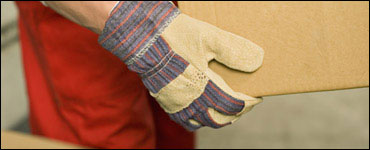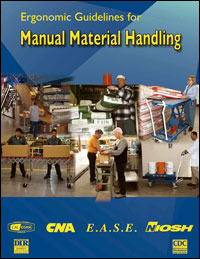CDC Features
Ergonomic Guidelines for Manual Material Handling

During an average work day, many workers are responsible for manual material handling, specifically the physical moving of individual containers by lifting, lowering, filling, emptying, or carrying them. Manual material handling (MMH) work contributes to a large percentage of the over half a million cases of musculoskeletal disorders reported annually in the United States. Musculoskeletal disorders often involve strains and sprains to the lower back, shoulders, and upper limbs. They can result in protracted pain, disability, medical treatment, and financial stress for those afflicted with them, and employers often find themselves paying the bill, either directly or through workers' compensation insurance. At the same time employers must cope with the loss of the full capacity of their workers.
Interventions Can Reduce Costs and Improve Productivity
Scientific evidence shows that effective ergonomic interventions can lower the physical demands of MMH work tasks, thereby lowering the incidence and severity of the musculoskeletal injuries they can cause. Their potential for reducing injury-related costs alone makes ergonomic interventions a useful tool for improving a company's productivity, product quality, and overall business competitiveness.
Productivity may get a solid shot in the arm when managers and workers take a fresh look at how best to use energy, equipment, and exertion to get the job done in the most efficient, effective, and effortless way possible. Now is a great time for employers and employees to review work tasks that involve lifting, lowering, filling, emptying, or carrying containers and consider options for effectively reducing the physical demands of – and potential injuries from – such MMH tasks. See Ergonomic Guidelines for Manual Material Handling.
The guidelines were published April 2007 by Cal/OSHA Consultation Service, Research and Education Unit, Division of Occupational Safety and Health, California Department of Industrial Relations in partnership with CNA Insurance, Ergonomic Assist Systems and Equipment (EASE) a Product Council of Material Handling Industry of America (MHIA), and CDC's National Institute for Occupational Safety and Health.
Engineering and Administrative Improvements

Ergonomic improvements are changes made to improve the fit between the demands of work tasks and the capabilities of the workers. In general, there are two types of ergonomic improvements:
• Engineering Improvements – including rearranging, modifying, redesigning, providing or replacing tools, equipment, workstations, packaging, parts, processes, products, or materials; and
• Administrative Improvements – observing how different workers perform the same tasks to get ideas for improving work practices or organizing the work.
The booklet Ergonomic Guidelines for Manual Material Handling provides diagrams, checklists, and resources for supervisors and managers as well as guidelines for safer work practices. The booklet includes specific information on:
• Easier ways to manually lift, lower, fill, or empty containers
• Easier ways to manually carry containers
• Alternatives to manual handling of individual containers
Additional Information
- Ergonomics and Musculoskeletal Disorders
- Safety Tips from National Safety Council
Page last modified: June 9, 2008
Content Source: National Institute for Occupational Safety and Health
Content owner: National Center for Health Marketing
URL for this page: www.cdc.gov/Features/ProperLifting



